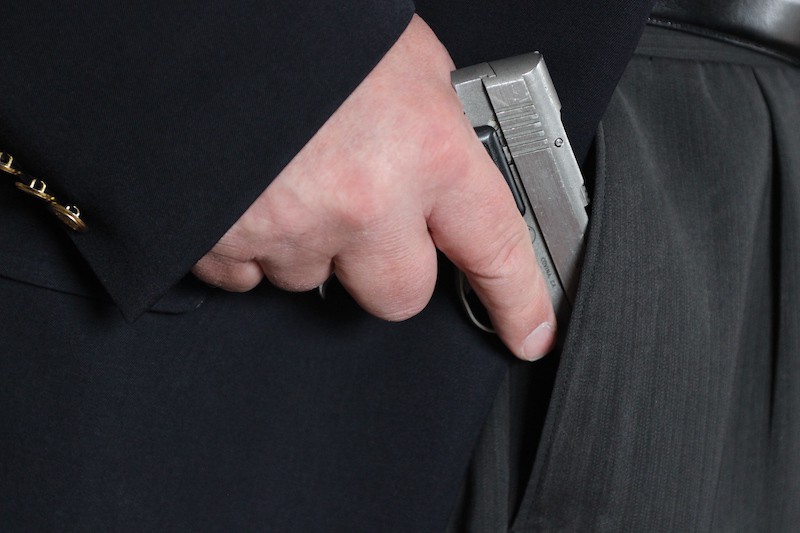The Pocket Protector
Is That A Gun Or Are You Just Glad To See Me?
There was a time when carrying “protection” in your pocket had a different meaning, at least to a randy 18-year-old guy. However, for those who are old enough to know better, the more common reference refers to keeping a small handgun concealed in your pocket as a means of protection.
Meanings
First off, before we get too wrapped up in semantics, there is no precise definition of what a “pocket gun” is or isn’t. Depending on your physical size and the style of your clothing, a pocket gun might be anything from a .22 derringer to a .45 ACP semi-automatic pistol or, really, anything. In my general estimation, most folks think of smaller guns chambered in .380 ACP or 9mm, though the term can cover a spectrum of calibers. There are even pocket .44 sixguns. Just ask John Taffin!
Just like every other “new” trend in shooting, pocket guns have been around since firearms were first invented. In the 1800s, no gentleman felt fully dressed without his pocket derringer to deal with ne’er-do-wells while some desperadoes cut down black powder cap-and-ball revolvers to keep as a literal “Ace in the Hole” in case of a bad deal at the poker table.
Though there were notable exceptions, smaller firearms of the past tended to suffer from reliability problems or were simply inferior quality, while the available ammunition had terrible terminal ballistics. With improvements in both firearm and ammunition technology, there has been a small resurgence of interest in this mode of carry.
Nowadays, it’s rare to find a really poorly-made firearm on the market, so even the smallest of guns tend to be reliable. Meanwhile, better ammunition has made smaller, less powerful cartridges perform significantly better on the receiving end. While not the first call for cops and counter-terrorism teams, having a mouse (gun) in your pocket is a reasonable choice for self-defense — within certain parameters.
Downsides
Better quality guns and ammunition have leveled the playing field somewhat but there are still major drawbacks with small pocket guns due to those pesty, non-negotiable laws of physics — less velocity (less wounding ability) due to shorter barrels, limited ammunition capacity, shorter sight radius and smaller grip and controls. These last three factors make pocket guns more difficult to shoot accurately.
In fact, here at GUNS, we often rail against the widespread misconception an airweight .38 revolver — a common pocket gun — is a great choice for novice shooters and arming spouses. Nothing could be further from the truth! Such guns are very effective in the hands of an expert but are nothing but a marvel of frustration for an inexperienced shooter.
When considering pocket carry, the question boils down to which is more important in your situation: concealability and convenience or having the ability to shoot larger bullets more accurately?
In most cases, concealability isn’t a critical factor and when it is, there are better, super-concealable ways to carry guns. The choice of a pocket gun, thus, frankly, boils down to a matter of convenience. However, unlike some uber-tactical authors, I’ll agree choosing NOT to be armed to the teeth at all times — including when in the hot tub or while undergoing surgery — is a reasonable lifestyle choice for most folks. It’s your life; live it how you want. Sometimes, this means picking a pocket gun.
And, please don’t lecture me on how I’ll be nothing but a victim carrying a little popgun when the squad of active shooters storm my local farmers market. At least I’ll have a gun, which is more than many people can say because it’s pretty obvious a large percentage of “CCW people” don’t carry a gun most of the time. To me, this is a far more critical error than the flavor of your chosen piece or caliber.
Since they’re more difficult to shoot accurately and often lack major advantages in the ammo department, I consider pocket guns mainly as a tool to expedite your escape from imminent harm. Someone else with a bigger gun can go hunting the bad guy(s). Essentially, to me, a pocket gun is better than a rock or club, but not by much.
Having said this, I also frequently carry a pocket pistol as a backup to the larger weapon concealed elsewhere or carried “off body.”

A pocket holster is simple-as-simple-gets. This Falco Black-Hawk is made from suede to anchor
it in your pocket during the draw. Photo: Falco Holsters

There are also synthetic pocket holsters. Most of these use some type of gummy surface treatment to anchor them,
such as this Falco Carey model. Photo: Falco Holsters
Don’t Drop In
When headed out the door, it’s a simple matter to drop a small gun into your pocket and go forth armed, with far fewer hassles than carrying a bigger handgun inside your waistband. However, I don’t mean literally mean “drop.” Putting any firearm, regardless of mechanical safeties, loose into a pocket is the height of folly.
The likely result is a negligent discharge and a bullet into your thigh or someplace even more sensitive. Pockets are the natural habitat of things like key rings, pocket knives, small flashlights, lip balm, money clips and all sorts of other pocket garbage, all of which will fit nicely within an unprotected trigger guard. Move the wrong way just once, and you get a real surprise in your pants. You DO … NOT want this to happen.
Fortunately, along with better ammo and gun choices, there are now many great holster options. Aside from the important matter of trigger security, the other main goal of a pocket holster is to keep the outline of the gun from being seen (“printing”) through your clothing. Therefore, heavier construction is better than lighter materials.

They even make pocket holsters for subcompact 9mm with an optic, such as this Simply Rugged Opti Grab holster.
Photo: Simply Rugged Holsters

Even if you carry inside-the-waistband, having a spare magazine secured in your pocket with this
Simply Rugged Pocket Mag Pouch makes for faster reloads. Photo: Simply Rugged Holsters
A pocket holster should also have a means to keep it from being withdrawn from the pocket when the gun is presented. Some use a non-slip surface or suede to grab the pocket lining, while others use an integral hook design to keep the holster in place. I’ve carried all the different types, and all seem to work fairly well. Fortunately, since pocket holsters are really nothing more than a fancy pouch, they’re fairly inexpensive, so the inevitable process of buy, try, buy another, try another is less painful than for belt holsters. If your current pocket holster is lacking in some way, just find another one until you hit the sweet spot for you.
If you plan to start using pocket carry, you owe it to yourself to actually try it on the shooting range. This can be off-limits for some ranges, so you might have to do dry practice at home. Regardless, if you haven’t made a significant number of practice presentations from your new rig, you’re really shortchanging yourself. Sometimes, it can be eye-opening the moment you discover your gear or technique just isn’t up to the task.
Ultimately, pocket carry is a great way to stay armed at all times without the hassle and discomfort of carrying a larger rig. While it’s not the optimal choice for a deadly confrontation, at least you have a fighting chance because you are armed. Pick a “decent” pistol of “reasonable” caliber, stoke it with high-quality ammunition, place it into a quality, tested holster, and then rest easy because you’ve got some solid protection in your pocket.
Even a teenager can understand that!
Want more online exclusives from GUNS Magazine delivered straight to your inbox? Sign up for our FREE weekly email newsletters.




